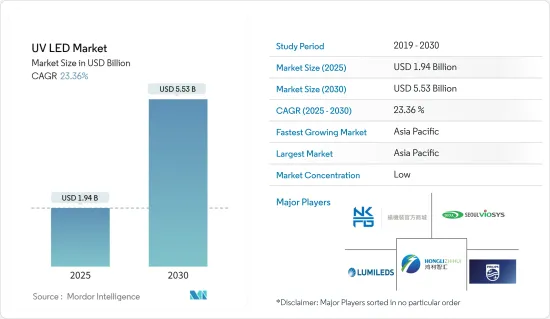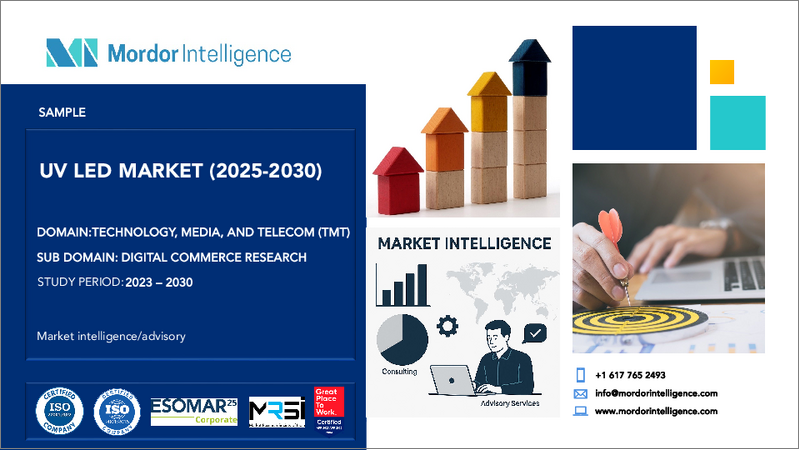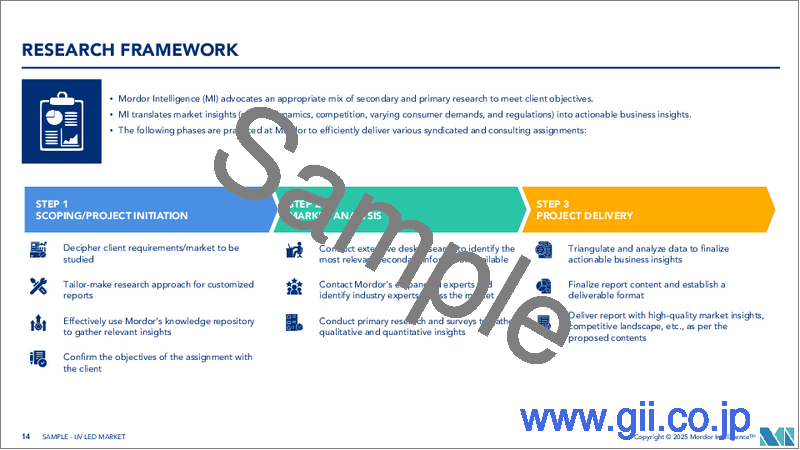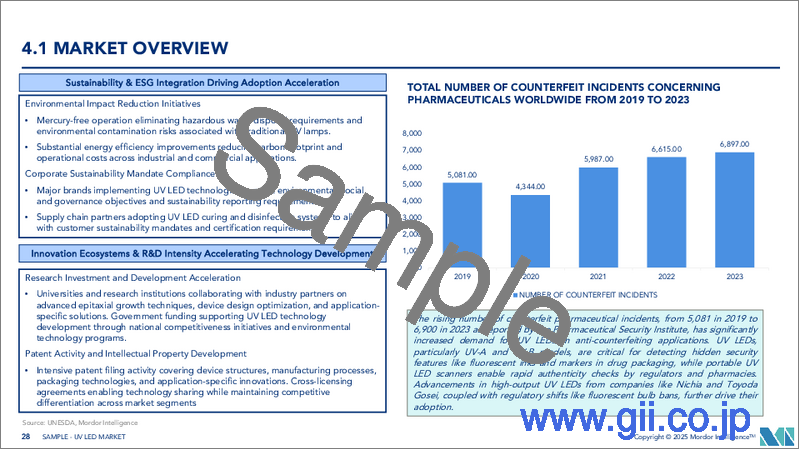|
|
市場調査レポート
商品コード
1687451
UV LED-市場シェア分析、産業動向と統計、成長予測(2025年~2030年)UV LED - Market Share Analysis, Industry Trends & Statistics, Growth Forecasts (2025 - 2030) |
||||||
カスタマイズ可能
適宜更新あり
|
|||||||
| UV LED-市場シェア分析、産業動向と統計、成長予測(2025年~2030年) |
|
出版日: 2025年03月18日
発行: Mordor Intelligence
ページ情報: 英文 159 Pages
納期: 2~3営業日
|
全表示
- 概要
- 目次
UV LED市場規模は、2025年に19億4,000万米ドルと推定され、予測期間(2025年~2030年)のCAGR 23.36%で、2030年には55億3,000万米ドルに達すると予測されています。

様々なアプリケーションでUV LEDの需要が伸びていること、ベンダーが技術をさらに強化し、新しい使用事例を生み出す努力を強めていることが、予測期間中に調査された市場の成長をサポートすると予測されています。
近年、UVランプ(水銀、エキシマ、キセノン、アマルガムなど)が何十年も稼働してきたアプリケーションでLEDの採用が大きく伸びています。また、UV-LEDの光束密度、安定性、稼働時間における最近の技術改良により、アーチランプ、熱陰極ランプ、冷陰極ランプ、水銀アークランプ、グリッドランプなどの従来のUV光源を置き換える効率的なソリューションとなっています。さらに、UV LEDは有害な水銀を使用せず、エネルギー消費量が少なく、オゾンを発生しないため、より環境に優しいという事実も、さまざまな用途での採用を後押ししています。
オプトエレクトロニクスでは、UV LEDは約200nmから400nmの製品で構成され、表面実装、スルーホール、COB(チップオンボード)などさまざまなパッケージスタイルがあります。UV LEDには多くのユニークなアプリケーションがあります。しかし、これらのLEDの応用例は、出力と波長に大きく依存します。
過去10年間で、LED技術の注目度は、消費者の受容の高まりと技術革新に後押しされて大きく高まりました。例えば、欧州委員会の共同研究センターと国際エネルギー機関(IEA)の推計によると、照明産業におけるLEDの普及率は、2012年のわずか1.8%から2030年には87.4%に成長すると推定されています。このような動向は、LED技術に対する認識と受容を促進し、調査対象市場にとって有利な見通しを生み出すと予想されます。
しかし、UV LEDのコストが高いことや、UV光がユーザーの健康に悪影響を与えることなどが、市場成長にとって大きな課題となっています。さらに、UV LEDの効率の低さや信頼性に関する問題は、調査した市場の成長にとって課題となる可能性があります。
COVID-19の発生により、UV LEDの世界市場は、表面の殺菌効果や殺菌特性により需要が大幅に伸びた。ヘルスケア分野は、パンデミック後に大きな後押しを受け、殺菌・消毒用途の高度なソリューションの需要を促進すると予測されています。
UV LED市場動向
UV-C LEDが主要市場シェアを占める
- ヘルスケア、ホスピタリティ、公共スペース業界を中心とした世界の衛生志向により、UV-C LEDベースのソリューションに対する需要が高まっています。これらのLEDは、消毒時間の短縮、化学薬品の使用量の減少、有害な製品別の不存在など、多くの利点を提供します。さらに、UV-C LED技術の進歩により、効率が向上し、寿命が長くなり、価格も手頃になっています。
- メーカーは現在、UV-C LEDの効率向上のための研究開発にリソースを割いており、より便利で様々な用途に適用できるようになっています。その結果、UV-C分野は大幅な拡大が見込まれ、UV LEDモジュールメーカー、コンポーネントプロバイダー、システムインテグレーターに貴重な機会を提供しています。殺菌の意義とUV-C LEDの利点に対する理解の高まりが、市場成長の大幅な増加を促進すると予測されています。
- UV-C LEDモジュールは、空気や水が循環するシステムでUV-C光を生成するのに役立ちます。UV-C LEDモジュールの成長を促進する重要な要因には、環境安全LEDの急速な使用拡大とUV硬化システムのアプリケーション増加があります。UV-C LEDは殺菌用として実用的であるため、水質浄化の採用急増がUV-C LED産業の成長を促進する重要な要因となっています。
- さらに、消費者製品や家電製品へのUV-C LED技術の統合は、予測期間中にUV-C LED市場を拡大する貴重な機会を創出すると期待されています。さらに、出力パワーと信頼性の進歩、最近のUV-C LEDの単価低下が市場の成長を大きく後押ししています。
アジア太平洋が著しい成長を遂げる見込み
- UV硬化プロセスにおけるUV LED技術の利用の増加が市場の成長を牽引しています。UV硬化プロセスは、従来の乾燥よりも好ましいです。結果がはるかに良く、不合格率が低く、プロセス全体が製品の溶解性と耐傷性を高めるからです。
- UV LEDは、エネルギー効率が高く、熱損失がほとんどなく、水銀を含まず、従来のUVランプよりもはるかに小さな設置面積で製造でき、光学設計が優れているため、コーティング産業における硬化目的に役立ちます。包装業界におけるUV硬化型接着剤の使用は、従来の接着剤システムよりも優れているため、国内で驚異的に伸びています。
- 日本の自動車産業は、世界でも有数の規模を誇る産業です。日本は、1960年代以降、自動車の生産台数が最も多い上位3カ国の1つです。日本には、トヨタ、スズキ、ホンダといった大手自動車メーカーがあります。これらの企業は、サービスセンターとともに日本国内に広く進出しています。自動車産業におけるUV硬化の応用が拡大していることから、同国での成長機会と市場の拡大が期待されています。
- 韓国はエレクトロニクス製造業が盛んなことで知られています。UV LEDは、UV硬化接着剤、コーティング剤、インクなどのエレクトロニクス製造工程で幅広く使用されています。エレクトロニクス産業が成長し続けるにつれて、製造業におけるUV LEDの需要は増加すると予想されます。
- その他アジア太平洋地域には、台湾、インド、シンガポールが含まれます。シンガポールの企業は、エンドユーザーの需要に応え、市場シェアを拡大するため、新製品の開発や既存製品への機能搭載を進めています。
UV LED産業概要
UV LED市場は、Lumileds Holding BV、Koninklijke Philips NV、NKFG Corporation、Hongli Zhihui Group、Seoul Viosysなどの大手企業が存在し、非常に断片化されています。市場の企業は、製品提供を強化し、持続可能な競争優位性を獲得するために、提携や買収などの戦略を採用しています。
- 2024年3月、日亜は人気の434シリーズパッケージに新しいUV-B(308nm)とUV-A(330nm)LEDの量産を開始しました。434シリーズのコンパクトな3.5mm x 3.5mmサイズはそのままに、新たに発売されたUV-BとUV-A LEDはそれぞれ90mWと100mW(350mA時)という業界トップクラスの出力を実現し、光束密度を最大化しました。
- クリスタルIS社は2023年11月、アムウェイが同社の家庭用水処理システム「eSpring」に同社のUVC LED技術を採用したと発表しました。UV LEDとeSpring e3カーボンフィルターのユニークな組み合わせにより、新しいeSpring浄水器は99.9999%の細菌、99.99%までのウイルス、99.9%までの嚢胞を死滅させる効果があります。また、UV C LEDの使用により、新型eSpring浄水器はより環境にやさしい製品となっています。
その他の特典:
- エクセル形式の市場予測(ME)シート
- 3ヶ月間のアナリスト・サポート
目次
第1章 イントロダクション
- 調査想定と市場定義
- 調査範囲
第2章 調査手法
第3章 エグゼクティブサマリー
第4章 市場洞察
- 市場概要
- 業界の魅力度-ポーターのファイブフォース分析
- 供給企業の交渉力
- 買い手の交渉力
- 新規参入業者の脅威
- 代替品の脅威
- 競争企業間の敵対関係
- COVID-19の影響、後遺症、その他のマクロ経済要因
第5章 市場力学
- 市場促進要因
- 環境に優しいUV LEDの構成
- UV硬化市場の採用増加
- 低総所有コストによる適応性の向上
- 市場抑制要因
- 製造の複雑化と技術的限界の増加
第6章 市場セグメンテーション
- 技術別
- UV-A
- UV-B
- UV-C
- 用途別
- 光学センサーと計測器
- 偽造品検出
- 殺菌
- UV硬化
- 医療用光治療
- その他の用途
- 地域別
- 北米
- 米国
- カナダ
- 欧州
- ドイツ
- 英国
- フランス
- アジア太平洋
- 中国
- 日本
- 韓国
- オーストラリア・ニュージーランド
- ラテンアメリカ
- ブラジル
- チリ
- メキシコ
- 中東・アフリカ
- アラブ首長国連邦
- 南アフリカ
- 北米
第7章 競合情勢
- 企業プロファイル
- Lumileds Holding BV
- Koninklijke Philips NV
- NKFG Corporation
- Hongli Zhihui Group
- Seoul Viosys Co. Ltd
- Nichia Corporation
- Semileds Corporation
- EPIGAP OSA Photonics GmbH
- CRYSTAL IS Inc.(Asahi Kasei Corporation)
- Luminus Inc.
- LITE-ON Technology Corporation
第8章 投資分析
第9章 市場機会と今後の動向
The UV LED Market size is estimated at USD 1.94 billion in 2025, and is expected to reach USD 5.53 billion by 2030, at a CAGR of 23.36% during the forecast period (2025-2030).

The growing demand for UV LEDs across different applications and increasing efforts made by vendors to enhance the technology further, giving rise to new use cases, are anticipated to support the growth of the market studied during the forecast period.
In recent years, the adoption of LEDs has grown significantly in applications wherein UV lamps (mercury, excimer, xenon, amalgam, etc.) have operated for decades. Recent technological improvements in the flux density, stability, and operating hours of UV-LEDs have also made them an efficient solution for replacing traditional UV light sources such as arch lamps, hot and cold cathode lamps, mercury arc lamps, and grid lamps. Moreover, the fact that UV LEDs are more environmentally friendly, as they do not use harmful mercury, consume less energy, and do not produce ozone, also supports its adoption across various applications.
In optoelectronics, UV LEDs consist of approximately 200 nm to 400 nm products with various package styles, including surface mount, through-hole, and COB (chip-on-board). There are many unique applications for UV LEDs. However, the application cases of these LEDs are greatly dependent on the output power and wavelength.
In the last decade, the prominence of LED technology has grown significantly, driven by increasing consumer acceptance and technological innovations. For instance, according to estimates by the European Commission's Joint Research Center and the International Energy Agency (IEA), the penetration of LEDs in the lighting industry is estimated to grow to 87.4% by 2030, from just 1.8% in 2012. Such trends are anticipated to drive the awareness and acceptance of LED technology, creating a favorable outlook for the market studied.
However, factors such as the higher cost of UV LEDs and the negative impact of UV light on users' health are significant challenges for the market's growth. Furthermore, lower efficiency and issues related to the reliability of UV LEDs may challenge the growth of the market studied.
With the outbreak of COVID-19, the global UV LED market witnessed a significant growth in demand due to its effectiveness in disinfecting surfaces and germ-killing properties. The healthcare sector received a significant boost post-pandemic, which is anticipated to drive the demand for advanced solutions for sterilization and disinfection applications.
UV LED Market Trends
UV-C LED to Hold Major Market Share
- The global focus on hygiene, especially in healthcare, hospitality, and public spaces industries, has increased the demand for UV-C LED-based solutions. These LEDs provide numerous benefits, such as shorter disinfection times, decreased chemical usage, and the absence of harmful byproducts. Moreover, advancements in UV-C LED technology have resulted in improved efficiency, longer lifespan, and greater affordability.
- Manufacturers are currently dedicating resources to research and development to improve the efficiency of UV-C LEDs, making them more convenient and applicable for various uses. Consequently, the UV-C sector is anticipated to experience considerable expansion, presenting valuable opportunities for UV LED module manufacturers, component providers, and system integrators. The growing understanding of the significance of disinfection and the benefits of UV-C LEDs is projected to drive a substantial increase in market growth.
- UV-C LED modules can help generate UV-C light in systems where air and water circulate. Some critical factors advancing the growth of UV-C LED modules include the rapid expansion of the use of environment-safe LEDs and the increase in the application of UV curing systems. Since UV-C LED is practical for disinfection, a surge in the adoption of water purification is a significant factor driving the growth of the UV-C LED industry.
- Furthermore, it is expected that the integration of UV-C LED technology into consumer products and household appliances will create a valuable opportunity to expand the UV-C LED market during the forecast period. Moreover, advancements in output power and reliability and the recent decrease in unit cost prices for UV-C LEDs are significantly driving the market's growth.
Asia-Pacific Expected to Witness Significant Growth
- The increasing use of UV LED technology in the UV curing process is driving the market's growth. The UV curing process is preferred over traditional drying, as the results are much better, rejection rates are low, and the entire process enhances the solvency and scratch resistance of the product.
- UV LED is helpful in curing purposes in the coating industries, as it is more energy-efficient, loses very little heat, contains no mercury, can be manufactured with a much smaller footprint, and has a far better optical design than traditional UV lamps. The use of UV-curable adhesives in the packaging industry is growing tremendously in the country, owing to their advantages over conventional adhesive systems.
- The Japanese automotive industry is one of the most prominent and largest industries in the world. Japan is one of the top three countries with the highest number of cars manufactured since the 1960s. The country is home to some of the major automotive players, such as Toyota, Suzuki, and Honda. These companies have an extensive presence in the country, along with their service centers. The growing application of UV curing in the automotive industry is expected to offer opportunities in the country and augment the market's growth.
- South Korea is known for its thriving electronics manufacturing industry. UV LEDs are used extensively in electronics manufacturing processes such as UV curing adhesives, coatings, and inks. As the electronics industry continues to grow, the demand for UV LEDs in manufacturing is expected to increase.
- The Rest of Asia-Pacific includes Taiwan, India, and Singapore. The companies in Singapore are developing new products or incorporating features in the existing products to meet the demand of the end users and increase their market shares.
UV LED Industry Overview
The UV LED market is highly fragmented with the presence of major players like Lumileds Holding BV, Koninklijke Philips NV, NKFG Corporation, Hongli Zhihui Group, and Seoul Viosys Co. Ltd. Players in the market are adopting strategies such as partnerships and acquisitions to enhance their product offerings and gain sustainable competitive advantage.
- In March 2024, Nichia started mass production of the new UV-B (308 nm) and UV-A (330 nm) LEDs in its popular 434 series package. While maintaining the compact 3.5 mm x 3.5 mm size of the 434 series, the newly launched UV-B and UV-A LEDs deliver industry-leading outputs of 90 and 100 mW, respectively (at 350 mA), thus maximizing flux density.
- In November 2023, Crystal IS Inc. announced that Amway had chosen its UVC LED technology for its eSpring home water treatment system. With a unique combination of UV LEDs and eSpring e3 carbon filter, the new eSpring water purifier is 99.9999% effective at killing bacteria, viruses up to 99.99%, and cysts up to 99.9%. The use of UV C LEDs also makes the new eSpring water purifier a more environmentally friendly product, as the new device consumes 25% less energy during active use compared to the previous model.
Additional Benefits:
- The market estimate (ME) sheet in Excel format
- 3 months of analyst support
TABLE OF CONTENTS
1 INTRODUCTION
- 1.1 Study Assumption and Market Definition
- 1.2 Scope of the Study
2 RESEARCH METHODOLOGY
3 EXECUTIVE SUMMARY
4 MARKET INSIGHTS
- 4.1 Market Overview
- 4.2 Industry Attractiveness - Porter's Five Forces Analysis
- 4.2.1 Bargaining Power of Suppliers
- 4.2.2 Bargaining Power of Buyers
- 4.2.3 Threat of New Entrants
- 4.2.4 Threat of Substitutes
- 4.2.5 Intensity of Competitive Rivalry
- 4.3 Impact of COVID-19, After Effects, and Other Macroeconomic Factors
5 MARKET DYNAMICS
- 5.1 Market Drivers
- 5.1.1 Eco-friendly Composition of UV LED
- 5.1.2 Rising Adoption of the UV Curing Market
- 5.1.3 Increasing Adaptability Fueled by Low Total Cost of Ownership
- 5.2 Market Restraints
- 5.2.1 Increasing Manufacturing Complexity and Technical Limitations
6 MARKET SEGMENTATION
- 6.1 By Technology
- 6.1.1 UV-A
- 6.1.2 UV-B
- 6.1.3 UV-C
- 6.2 By Application
- 6.2.1 Optical Sensors and Instrumentation
- 6.2.2 Counterfeit Detection
- 6.2.3 Sterilization
- 6.2.4 UV Curing
- 6.2.5 Medical Light Therapy
- 6.2.6 Other Applications
- 6.3 By Geography
- 6.3.1 North America
- 6.3.1.1 United States
- 6.3.1.2 Canada
- 6.3.2 Europe
- 6.3.2.1 Germany
- 6.3.2.2 United Kingdom
- 6.3.2.3 France
- 6.3.3 Asia-Pacific
- 6.3.3.1 China
- 6.3.3.2 Japan
- 6.3.3.3 South Korea
- 6.3.3.4 Australia and New Zealand
- 6.3.4 Latin America
- 6.3.4.1 Brazil
- 6.3.4.2 Chile
- 6.3.4.3 Mexico
- 6.3.5 Middle East and Africa
- 6.3.5.1 United Arab Emirates
- 6.3.5.2 South Africa
- 6.3.1 North America
7 COMPETITIVE LANDSCAPE
- 7.1 Company Profiles
- 7.1.1 Lumileds Holding BV
- 7.1.2 Koninklijke Philips NV
- 7.1.3 NKFG Corporation
- 7.1.4 Hongli Zhihui Group
- 7.1.5 Seoul Viosys Co. Ltd
- 7.1.6 Nichia Corporation
- 7.1.7 Semileds Corporation
- 7.1.8 EPIGAP OSA Photonics GmbH
- 7.1.9 CRYSTAL IS Inc. (Asahi Kasei Corporation)
- 7.1.10 Luminus Inc.
- 7.1.11 LITE-ON Technology Corporation






